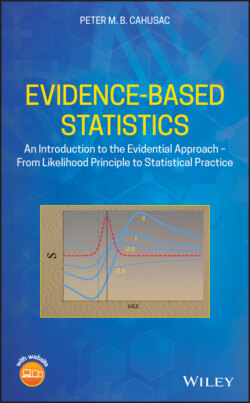Читать книгу Evidence-Based Statistics - Peter M. B. Cahusac - Страница 15
1.1.1 The Literature
ОглавлениеThe use of evidence based on likelihoods and likelihood ratios (LRs) strikes those unfamiliar with it as highly specialized and esoteric, even arcane. There is widespread belief, though misguided, that evidential methodology can only be used safely and credibly by highly experienced or professional statisticians. A contributing factor supporting this belief is the fact that, compared with other areas of statistical methodology, there are relatively few books and research papers on the evidential approach. However, the quality of the texts makes up for their quantity.
The most important book on the subject is Likelihood by Edwards. Originally published in 1972, it represented a highly original text. An expanded edition was subsequently published in 1992 [3]. A.W.F. Edwards (below photo) is a statistician and geneticist who did his PhD with R.A. Fisher, who was also a statistician and geneticist. Edwards's ground-breaking book covers a remarkable range of topics. Sometimes densely written, other times appearing to cover important topics, such as the F ratio, in a cursory fashion. The succinct text, peppered with dry humour and understatement, repays careful reading and re-reading. Many glittering gems relevant to applied statistics await to be mined and polished.
Professor A.W.F. Edwards FRS. Source: Photo from Gonville and Caius College, Cambridge.
Royall's book [4], Statistical Evidence: A Likelihood Paradigm, published 25 years later is a remarkable monograph, providing a tour de force of carefully argued prose and examples to convince anyone still in doubt about the merits of the evidential approach. The book adds to Edwards's work, for example by explaining how sample size calculations relevant to the evidential approach can be done.
The books by Edwards and Royall are outstanding sources of reference for theory and examples. They make an appeal to reason as to why statistical inferences based on statistical tests and Bayesian methods are flawed, and that only the likelihood approach is valid. These books may appear somewhat inaccessible to readers who lack sufficient mathematical or statistical expertise.
A deep theoretical and philosophical treatment of the likelihood approach is given by Hacking [5]. This may appeal to philosophers and theoreticians but there is little there for the applied statistician or researcher.
There are some excellent books with large sections devoted to the evidential approach. First up is the book by Dienes with his excellent, cogent, and entertaining Understanding Psychology as a Science: An introduction to Scientific and Statistical Inference [6]. Then, there is the very solid and thorough treatment by Baguley in Serious Stats: A Guide to Advanced Statistics for the Behavioral Sciences [7]. Both these books offer limited computer code to perform LR calculations. Taper and Lele edited The Nature of Scientific Evidence: Statistical, Philosophical, and Empirical Considerations which consists of a compilation of chapters including some notable authors, such as Royall, Mayo, and others [1]. There are commentaries to the chapters, including by D.R. Cox who was critical of Royall's approach, which was followed by a robust and memorable rejoinder by Royall.
The book by Aitken is a useful addition, but is limited in scope to forensic statistical evidence [8]. Pawitan's In All Likelihood is a useful mathematical treatment of a range of likelihood topics [9]. Clayton and Hills's Statistical Models in Epidemiology [10] is excellent but limits itself to epidemiological statistics. Lindsey's book Introductory Statistics: A Modelling Approach [11], makes extensive use of the likelihood approach. Kirkwood and Sterne's Medical Statistics [12] is a useful practical book that devotes a chapter to likelihood. Armitage et al's Statistical Methods in Medical Research [13] is a solid standard reference work for medical statistics which makes passing references to the likelihood approach. There are some excellent books that use a modelling approach, although without likelihoods, for example Maxwell and Delaney's Designing Experiments and Analyzing Data: A Model Comparison Perspective [14] and Judd et al's Data Analysis: A Model Comparison Approach to Regression, ANOVA, and Beyond [15].
Perhaps the most concentrated account of likelihood, given in just a few pages, is by Edwards in a 2015 entry for an encyclopaedia [16]. There are a number of accessible research papers. Those by Goodman [17–21] (one of these jointly with Royall), and Dixon and Glover [22, 23] are exemplary in explaining and demonstrating a range of evidential techniques.
